Emir Mohamed I Park - The Heart of Madrid
Thursday, April 28, 2022
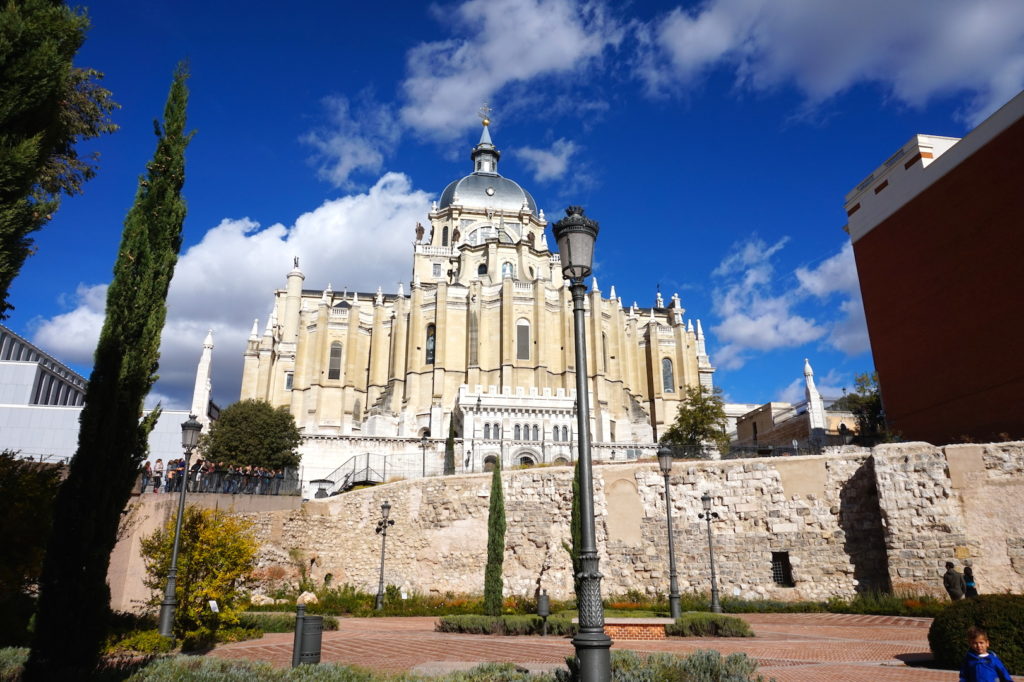
In the city of Madrid, there are parks that are well known by locals and tourists, such as El Retiro and El Capricho. However, there are others that go completely unnoticed and whose visit is well worth it. This is the case of the Emir Mohamed I park, an Andalusian-style Arab park in Madrid with beautiful green areas that can be visited on weekends and holidays from 10:00 a.m. to 9:00 p.m.
In 1954 the Arab wall was declared Historic-Artistic Heritage, although the archaeological work did not begin until much later. The first excavation campaign took place between 1972 and 1975. After the last excavation campaign, between 1987 and 1988, the area was abandoned.
Until 2010, what is now the Emir Mohamed I park, was just a plot of land. Between the years 2010 and 2011, the Madrid City Council rebuilt it as a park, giving the complex the shape of a star. The works were promoted by the Environment Area of the Madrid City Council and financed by the Plan E for Local Investment, of the Government of Spain.
In 2016, the Culture Area of the Madrid City Council began a project to promote the wall restoration project. The importance of this development lies in the fact that Madrid is the only capital of Arab-Islamic origin in Europe. Moreover, its name is a hybrid of Arabic and Romance: "Mayrit", which refers to the watercourses that run through the area where the Emir Mohamed I park is located.
The city of Mayrit was founded by the Emir Mohamed I between the years 853 and 865. It was born as a small town and a fortress on the hills of the Manzanares valley to keep an eye on the rebels of Toledo and defend the Middle March from Christian attacks.
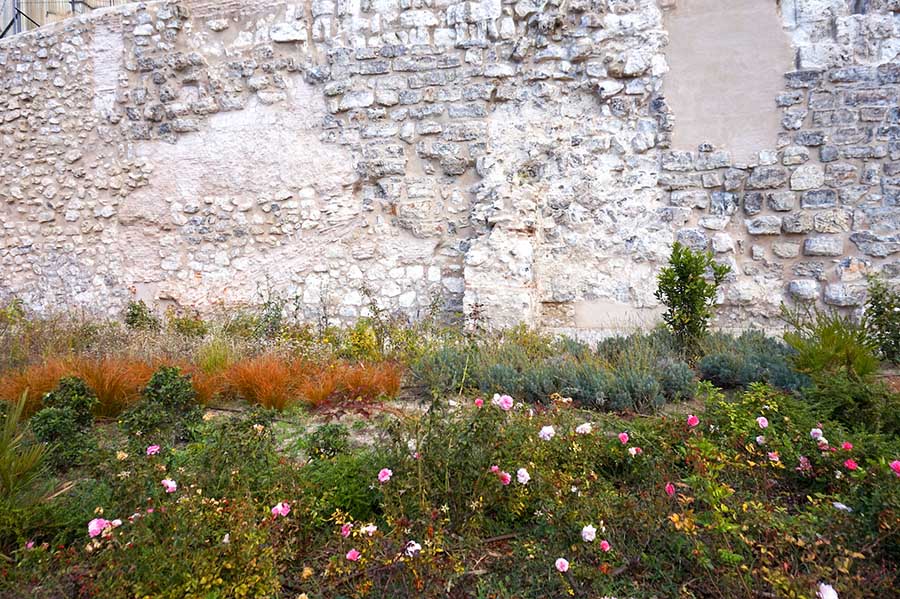
The remains of the Islamic period are located mostly in the historic centre of Madrid, around the Almudena Cathedral, the Cuesta de la Vega, the Calle Mayor and the Palacio de Oriente, the Arab wall is, without doubt, the most remarkable and oldest, although remains of silos have also been preserved, as well as hydraulic structures. The techniques of capturing water brought from the East, the qanats, or underground channels, began to develop at this time and are the origin of the extensive network known as "water journeys", which supplied Madrid along long routes for centuries, until the construction of the Canal de Isabel II, and which are still partially preserved.
Already from a later period, various monuments survive in Madrid, both religious and civil, in the Mudejar style, built by Muslim master builders after the Christian conquest, which took place in 1083 by the troops of the King of Castile and León, Alfonso VI. Among them, the church of San Nicolás de Bari stands out, perhaps the oldest in the capital, as well as that of San Pedro el Viejo, both in the historic centre.
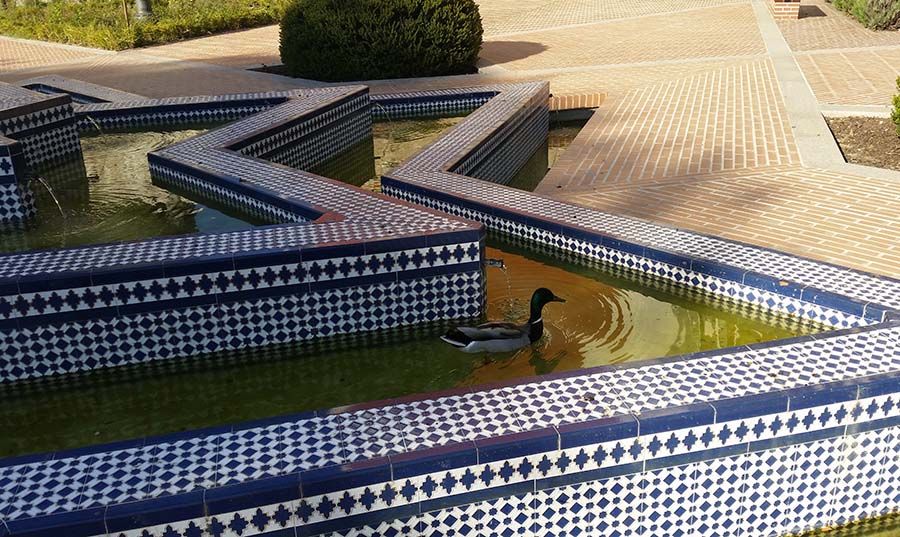
However, The Arab Park is located in the heart of Madrid, on the Cuesta de la Vega, on one of the sides of the Almudena Cathedral. The remains of the Islamic wall that delimit part of the park belong to the first walled enclosure of Madrid, which was rightfully declared a Historic Site in 1954.
One of the main attractions of the enclosure is the fountain in the shape of a six-pointed star. In addition, a parterre runs along the wall, and very old trees stand out in the green areas.
Without a doubt, the Emir Mohamed I Park is a highly recommended visit in Madrid.
 0
Like
Published at 10:09 AM Comments (0)
0
Like
Published at 10:09 AM Comments (0)
The Easter Processions Return
Thursday, April 14, 2022

Spain is completely transformed during Easter week. Everybody, everywhere, turns out to experience one of Spain's most traditional events to the full. Don't miss the chance to visit this event: you'll be able to share some very special moments in an atmosphere unlike anything you've ever known.
.jpg) There are many different ways to discover Spain: enjoying its coast and beaches, following a route around its various monuments, exploring the countryside, playing sports like golf... However, if you've never visited Spain during Easter week, then you simply have to come. And even if you already know this famous fiesta, it's well worth making another trip, as each region of Spain has its own way of celebrating the event. There are many different ways to discover Spain: enjoying its coast and beaches, following a route around its various monuments, exploring the countryside, playing sports like golf... However, if you've never visited Spain during Easter week, then you simply have to come. And even if you already know this famous fiesta, it's well worth making another trip, as each region of Spain has its own way of celebrating the event.
In Spain, Easter week is celebrated with a great deal of emotion. People take an active role in its events and traditions. All day and night the streets are filled with the beat of the drums, masses of colourful flowers, and the consummate art of religious sculpture, all combining to produce a highly moving atmosphere.
Easter week is celebrated in every city, town and village in Spain. Nevertheless, there are some fiestas that are especially well known for their uniqueness and beauty, and have received the International Tourist Interest designation.
During Easter week in Seville you'll see how the “cofradías” (religious brotherhoods) manage to withstand the colossal weight of elaborately decorated statues of the Virgin Mary as they parade through the narrow streets of the old town. Easter week in Malaga includes the ritual privilege of the freeing of a prisoner, and one of the most moving moments of all is when the figure of Jesus Christ blesses the convict. During the Easter week celebrations in Cuenca you can also enjoy the concerts in the Religious Music Week festival, which take place in historic buildings such as the cathedral.
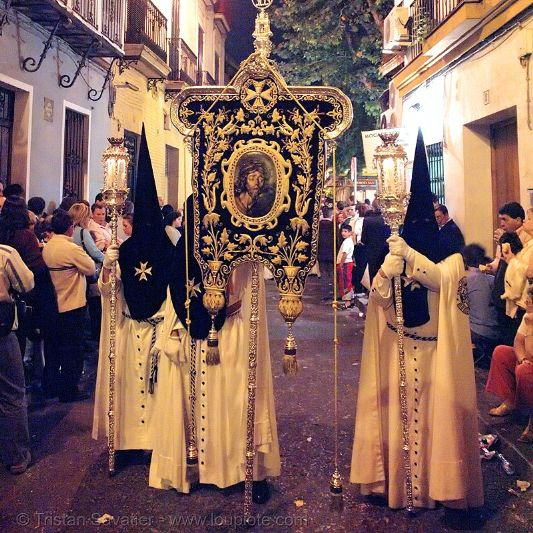
If you go to León in Easter week, you'll find one of the highlights is the encounter between Saint John and the Virgin Mary in the Plaza Mayor square, which marks the end of the Easter processions. During Easter week in Zamora, the sound of Gregorian chant provides an incredible atmosphere for the nocturnal processions. During the Easter week processions in Valladolid, make sure to look closely at the religious statues –they are priceless works of Baroque art. Easter week in Salamanca is spectacular on account of the backdrop formed by the city's stunning monuments.
The Palm Sunday procession in Elche features the customary palm leaves and is one of the most beautiful of any held in Spain. In Cartagena the culmination of the processions is especially moving, with thousands of people joining their voices in song to intone the Salve Maria to the Virgin Mary. Lorca is especially original – the processions include figures and scenes from the bible and from ancient civilisations. In the province of Albacete, the crowning moment in Easter week in Hellín is “the tamborada”, when the sound of up to 20,000 drums invades the town. Easter week in Cáceres is unique for its cofradías dating from the 15th century, and Eater week in Murcia has moments of breathtaking emotion such as on Easter Saturday, when the procession of 'Cristo Yacente' passes beneath the Santo Domingo arch .
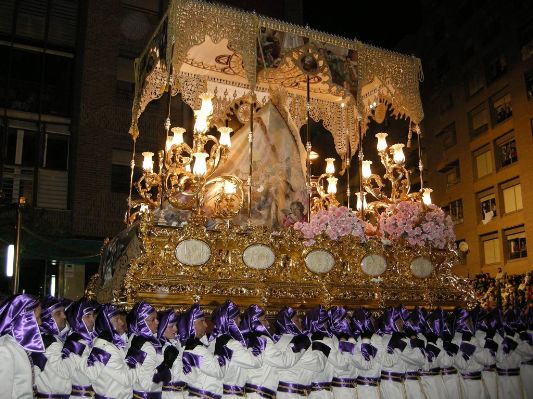
However of all these celebrations the most renowned and publicised is that of Seville. These celebrations are famous for their statues of the Virgin Mary with canopies: they are Baroque statues with silver and gold crowns, embroidered cloaks and velvet tunics, which only reveal face and hands.
.jpg)
Seville has been holding its Easter week celebrations since the 16th century, and they have become universally famous. Some 50,000 people put on traditional robes to parade in the 58 organised processions, while the "costaleros" carry the “pasos” (religious statues) on their shoulders. There are processions in the evening and at night every day. Each brotherhood sets out from its church and has an established route, although they must all pass the so-called “official section”, which starts in Calle Campana and finishes passing by the Cathedral. Once each procession has left the Cathedral, it returns to its church on a different route to that followed on the way out. The “saetas” are very emotional moments of the processions: these are solemn flamenco songs, recited “a cappella” from the balconies in honour of the statues.
The early hours of Good Friday constitute the most important time of the Seville Easter week celebrations. That night, some of the most venerated statues make their way through the streets, such as Jesús del Gran Poder, la Macarena, la Esperanza de Triana and el Cristo de los Gitanos. The streets of the city fill with people and with emotion all night and well into the following morning. However one needs to be patient because the waits to admire these beautiful statues tend to be long.
You can see processions by heading for any point on their routes, except in the “official section”. Here there are seats and stands from which to admire the passing processions, which must be reserved by contacting the Consejo Superior de Hermandades y Cofradías (Brotherhoods’ Association).
Easter week is one of the most spectacular and emotional fiestas in Spain. Religious devotion, art, colour and music combine in acts to commemorate the death of Jesus Christ.
Palm Sunday as we know is the celebration that commemorates Jesus’ triumphant arrival in Jerusalem and always sees large crowds of people in attendance.
The Palm Sunday Procession is held on the Sunday before Easter week. This fiesta has special importance in Elche. Its origins date back to the end of the 14th century. Hundreds of people take part by carrying figures hand-crafted in the town from palm branches, a truly beautiful spectacle.
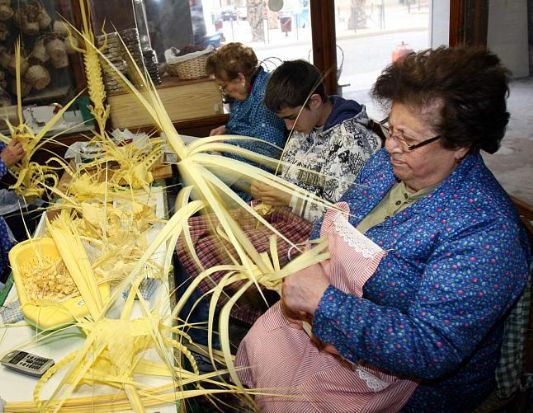
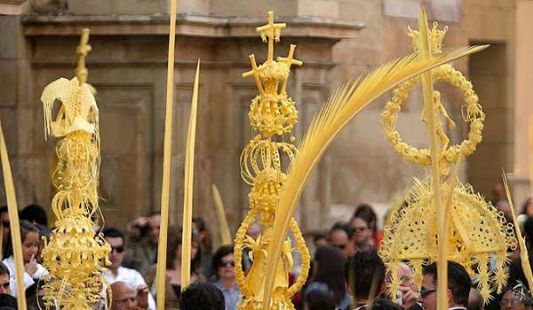

Elche is the only place in the world where the tradition of crafting white palm fronds lives on. This town has been exporting palm frond creations to other countries for centuries. Palm branches are used, which, after being treated, are plaited into beautiful, creative forms and figures. Not to be missed at this fiesta is the palm-figures competition organised by the Religious Brotherhoods of Easter Association. The works presented for the competition are exhibited over the course of the weekend in the Council Chamber of the Town Hall. It is free of charge and you can admire, from up close, these beautiful, complex images created by hand.
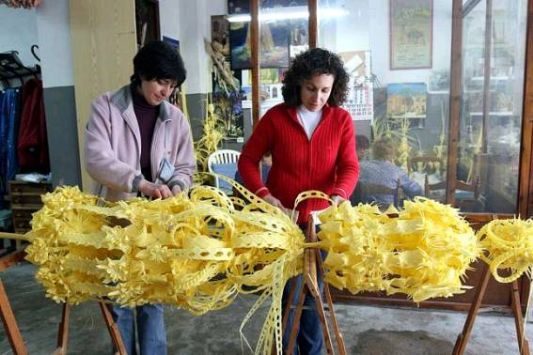
.jpg)
 1
Like
Published at 9:21 PM Comments (0)
1
Like
Published at 9:21 PM Comments (0)
El Rocio - The Spanish Pilgrimage
Friday, April 1, 2022
This pilgrimage of El Rocio is the most famous in the region, attracting nearly a million people from across Andalucia and the entire country, and beyond. Every Andalucian city, town and village has its own pilgrimages, for its patron saint, virgin or other much-loved local figure. But the El Rocio has cult status, and is the most important and most colourful. It follows on from Semana Santa (March/April), and the various spring ferias, of which Seville's Feria de Abril (April) is the biggest.
.jpg)
This cult dates back to the 13th century, when a hunter from the village of Villamanrique (or Almonte, depending on which version of the story you follow) discovered a statue of the Virgin Mary in a tree trunk in the Doñana park. A chapel was built where the tree stood, and it became a place of pilgrimage. Devotion to this particular version of the Virgin was initially a local affair. Then, by the 17th century, hermandades (brotherhoods) were making the trip from nearby towns at Pentecost; by the 19th century, they came from all over Huelva, Cadiz and Seville, on a journey taking up to four days. Over the next century, the cult of the Virgin del Rocio became more and more widespread, and these days participants come from as far away as Barcelona and the Canary Islands - not to mention tourists who travel from abroad, around Europe and even further afield.
The object of the pilgrimage is a 13th-century statue of the Virgen Del Rocio (Virgin of the Dew), in the town of the same name. El Rocio is in Huelva province, in the heart of the Doñana park, between Almonte and the coast. Most pilgrims, known as rocieros, approach the town through the park itself.
The town of El Rocío is a sprawling, pretty Wild-West-style place (you tie your horse to a wooden rail with a sign saying "Reservado Caballos" - reserved for horses - while you have a drink or a meal), with sandy, unpaved roads (easier on the hooves). For a few days in late May or early June, Catholic hermandades (brotherhoods) and countless others flock from all over Andalucia, Spain, and beyond, to the town, to pay tribute to the Virgin del Roció, housed in her own church in the town.
Until the 1950s the town had only a few houses, and everyone camped in their wagons. Now, each of the 90 or so brotherhoods has its own house with stables, as well as its own chapel, with its name displayed at the front. Its members and their friends and families, and their horses, eat and sleep here during the pilgrimage weekend. People bring mattresses and bed down anywhere they can. There are impromptu parties, open-air masses, horse races and competitions between the hermandades. And lots of singing and dancing, at all hours of the day and night. These brotherhoods also stay at their houses at weekends throughout the year, with their families in tow, making each visit into a big fiesta.
The pilgrimage takes place over the weekend before Pentecost Monday, the seventh weekend after Easter. People start arriving on the Friday before, and leave again on Tuesday.
Every late May, or early June, in villages and cities across Andalucia (especially the western part), you can see the locals gear up their covered wagons and don traditional Andalucian clothing - broad-brimmed hats and traje corto for men (grey, brown or black trousers, often with Western-style leather chaps, and boots), and flamenco dresses for women - a slightly different style, with a fuller skirt than the fitted Feria dresses - to head off to the El Roció shrine, accompanied by their own virgin on her simpecado (float).
Some still make the journey the traditional way, on horseback, or in picturesque gypsy-style covered wagons (reminiscent of the Wild West), adorned with flowers (either real or imitation), with curtains tied back, offering a glimpse of the interior. These are pulled by pairs of oxen, whose yokes have decorated leather headpieces, and bells hanging round their necks. It is a spectacular sight - one not to be missed if you are in the area (especially Western Andalucia) that week. In Seville, for example, groups of horse-riders (men are called jinetes, women amazonas) and processions of gypsy caravans from the Seville brotherhoods, gather by the cathedral on the Wednesday morning before, as they prepare to set off on their pilgrimage to El Rocio. They return the following Wednesday. Other hermandades leave from all over Andalucia, earlier in the week.
.jpg)
There are three main, traditional routes, and most hermandades, wherever they are arriving from, eventually join one of these. These depart from Triana (Sevilla, to the north-east), Sanlucar de Barrameda (south), and Huelva (west).
People also travel in big trailers pulled by tractors, ideally with shade as it can get very hot, as well as lots of food and drink. The rocieros sit on benches along the sides of the trailers, including many children who go on the pilgrimage every year. The more practical and comfortable, though less attractive, option is a big white caravan, with the same curved roof as the traditional models, complete with air-con and running water. This is pulled by a 4x4, as the route takes rocieros through the Doñana park, including several river crossings, so a tough vehicle is essential.
.jpg)
Rocieras (flamenco style songs) are joyfully sung about the Pilgrimage. Everyone sings rocieras (flamenco-style songs about the pilgrimage) as they travel, and again at night around the campfire when the hermandades have stopped to eat, drink and dance and make merry, accompanied by plenty of wine. It is alleged by some that the annual baby boom which happens nine months after El Rocio always includes offspring produced as a result of extra-marital dalliances.
To reach the shrine, pilgrims must cross part of the Doñana park, which is a protected area full of rare wildlife, including the famous lynx wild boar, horses, and many water birds on the marisma (wetlands) such as flamingos, herons, storks and egrets. Law enforcement is well organised, with Guardia Civil and others working hard not only to keep order, but also to protect the environment. Fire is a special concern, as this event is one long party involving copious amounts of drinking and smoking. Information campaigns combine with round-the-clock surveillance in order to keep both participants and Doñana safe every year. Volunteers follow the rocieros to collect the thousands of kilos of rubbish left behind.
It has been criticised by many for the "hedonistic" and "pagan" aspect of the encampments, which is compared to the tales of Chaucer or Boccaccio; the absurd prices of real estate in El Rocío, where even the humblest house is now worth millions of euros; and the ecological impact on the surrounding Doñana National Park or Coto de Doñana, especially since the introduction of motor vehicles
In the early hours of Pentecost Monday, the Virgin is brought out of her church by the Almonte hermandad, who claim her as their own. A tussle ensues between the various other brotherhoods for the honour of carrying her to the next chapel, and so she journeys around the town, visiting all the hermandades' chapels, for the rest of the day. Popularly known as La Paloma Blanca (the White Dove), she is an object of massive veneration in Andalucia, and huge crowds push and shove just to get the chance to touch the glass case in which the Virgin sits, as she sways dangerously from side to side. People even lift small babies up to touch her. This remarkable, chaotic event is always televised by Canal Sur, the Andalucian regional TV station.
.jpg)
If you are not able to go on the El Rocio pilgrimage, the town of El Rocio itself is worth a visit at any time of the year. The modern church of Nuestra Señora del Rocio, dating from the 1960s, is a stunning sight when viewed from across the water (stop off at the restaurant by the entrance to the town), where the dazzling white sanctuary stand out like a beacon against the verdant green of the marisma, inhabited by wild horses, and the deep blue of the sky.
Equestrians will find plenty of shops offering riding gear, from (Western-style) tack, to all kinds of hats and boots, leather bags and woollen shawls, as well as flamenco dresses. If the wooden houses with verandas looks familiar, it's because the Spanish pioneers took their style of architecture with them from Andalucia when they sailed to North America.
Ver mapa más grande
BEST TIME TO VISIT : THE FIRST MONDAY AFTER PENTECOST SUNDAY (WHIT SUNDAY)
HERE IS A LINK TO CHECK WHICH DAY IT FALLS ON EACH YEAR : www.rocio.com/index.php
 1
Like
Published at 6:51 PM Comments (0)
1
Like
Published at 6:51 PM Comments (0)
Spam post or Abuse? Please let us know
|
|